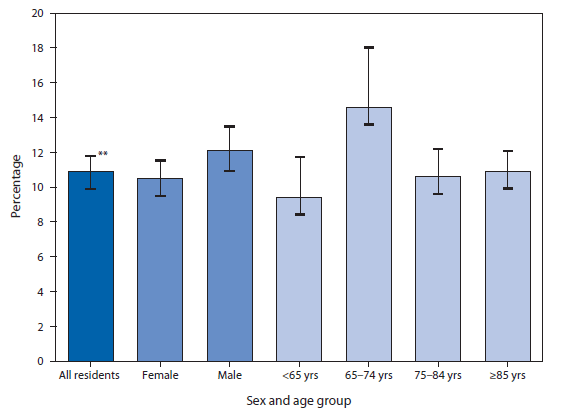QuickStats: Prevalence of Stroke* Among Residential Care Residents,† by Sex§ and Age Group¶ — National Survey of Residential Care Facilities, United States, 2010

* Respondents, who typically were residential care community directors, were asked, "As far as you know, has a doctor or other health professional ever diagnosed this resident with a stroke?"
† Residential care residents refer to persons living in assisted living and similar places (e.g., personal care homes and adult care homes, board and care homes, and adult foster care) on any given day in 2010. Residents in nursing homes were excluded. Those with missing data for stroke (0.6%) were excluded.
§ Differences between female and male residents significant at p<0.10.
¶ Differences between residents aged 65–74 years and residents in the other three age groups were statistically significant at p<0.05.
** 95% confidence interval.
In 2010, approximately 11.0% of residential care residents had been diagnosed with a stroke. About 12.0% of male residents and 10.5% of female residents had been diagnosed with a stroke. Residents aged 65–74 years had the highest prevalence of stroke (14.6%) compared with the other age groups.
Source: National Survey of Residential Care Facilities, 2010. Available at http://www.cdc.gov/nchs/nsrcf.htm.
Reported by: Christine Caffrey, PhD, gwo9@cdc.gov, 301-458-4137; Manisha Sengupta, PhD.
Alternate Text: The figure above shows the prevalence of stroke among residential care residents, by sex and age group, based on findings from the National Survey of Residential Care Facilities conducted in the United States in 2010. About 12.0% of male residents and 10.5% of female residents had been diagnosed with a stroke. Residents aged 65-74 years had the highest prevalence of stroke (14.6%) compared with the other age groups.
Use of trade names and commercial sources is for identification only and does not imply endorsement by the U.S. Department of
Health and Human Services.
References to non-CDC sites on the Internet are
provided as a service to MMWR readers and do not constitute or imply
endorsement of these organizations or their programs by CDC or the U.S.
Department of Health and Human Services. CDC is not responsible for the content
of pages found at these sites. URL addresses listed in MMWR were current as of
the date of publication.
All MMWR HTML versions of articles are electronic conversions from typeset documents.
This conversion might result in character translation or format errors in the HTML version.
Users are referred to the electronic PDF version (http://www.cdc.gov/mmwr)
and/or the original MMWR paper copy for printable versions of official text, figures, and tables.
An original paper copy of this issue can be obtained from the Superintendent of Documents, U.S.
Government Printing Office (GPO), Washington, DC 20402-9371;
telephone: (202) 512-1800. Contact GPO for current prices.
**Questions or messages regarding errors in formatting should be addressed to
mmwrq@cdc.gov.
 ShareCompartir
ShareCompartir


